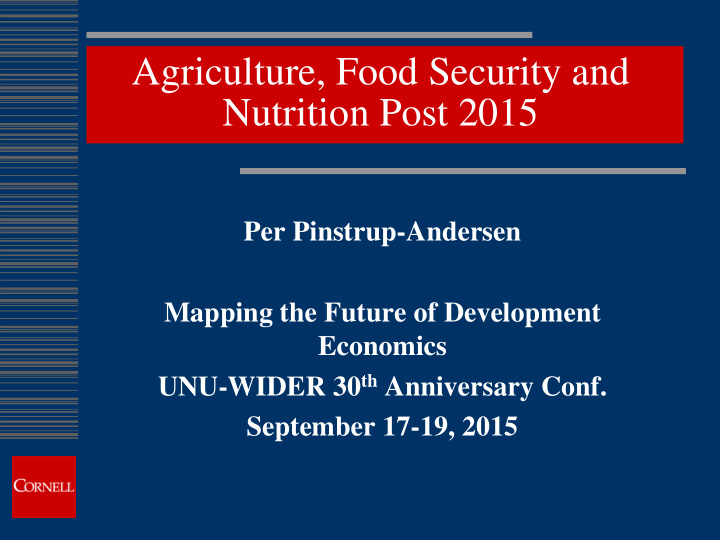



Agriculture, Food Security and Nutrition Post 2015 Per Pinstrup-Andersen Mapping the Future of Development Economics UNU-WIDER 30 th Anniversary Conf. September 17-19, 2015
17 Sustainable Development Goals and 169 Targets Eradicate extreme poverty by 2030 End hunger and food insecurity by 2030 End all forms of malnutrition by 2030 Double agricultural productivity by 2030 Ensure sustainable food production systems by 2030 Universal access to safe water and sanitation
The Food Crisis Arrived!
Total World Cereals Production World Production 3000 +23.3% 2500 2000 1500 1000 500 0 2005/06 2006/07 2007/08 2008/09 2009/10 2010/11 2011/12 2012/13 2013/14 2014/15 Est 2015/16 World Production
Total World Cereals Stock 700 +31.3% 600 500 400 300 +70.8% 200 100 +81.6% 0 2005/06 2006/07 2007/08 2008/09 2009/10 2010/11 2011/12 2012/13 2013/14 2014/15 Est 2015/16 Closing Stocks China India
World Market Price Change August 2012-August 2015 Cereals -39 % Food -27 % Source: FAO. September 2015
Maize (Corn) Monthly Price U.S. Dollars per Metric Ton 2005-2015 2005-2015: + 71% 2012-2015: - 50% Source: Index Mundi, 2015
Long-Term Price of Maize in Real Terms, 1908-2024 Source: OECD-FAO Agricultural Outlook 2015 & OECD/FAO 2015
Wheat Monthly Price U.S. Dollars per Metric Ton 2005-2015 2005-2015: + 71% 2012-2015: - 50% June 2005-2015: + 48% June 2012-2015: - 25% Source: Index Mundi, 2015
Rice Monthly Price U.S. Dollars per Metric Ton 2005-2015 2005-2015: + 36% 2012-2015: - 39% 2005-2015: + 71% 2012-2015: - 50% Source: Index Mundi, 2015
2,900,000,000,000 Pounds of Food Lost Every Year 2-3 Billion More People Could be Fed
Annual Average Population Growth Rate, % 2.5 2 1.5 1950-2000 2000-2050 1 2050-2100 0.5 0 World More Developed Less Developed Regions Regions
Billions of Middle Class Asians and Percent of the Global Middle Class 2009-2030 Year Billions Percent 2009 0.5 28 2020 1.7 54 2030 3.2 66 Source: Kharas 2010
The Asian Middle Class’ Purchasing Power (Billions 2005 PPP Dollars) and Percent of the World’s Middle Class’ Total Purchasing Power Year Billions Percent 2009 5.0 23 2020 14.8 42 2030 32.6 59 Source: Kharas 2010
Change in the Contribution of Each Food Group to Energy Intake 1980-2005
The Triple Burden of Malnutrition 1. Energy and protein deficiencies: Hunger 2. Specific nutrient deficiencies: Hidden Hunger 3. Excessive net energy intake: Overweight & Obesity
Hunger Trends for Developing Regions Source: FAO Hunger Map, 2014 .
Decrease in the Number of Undernourished 1990-92 to 2014-16 (millions) Global Total 203 China 155 (3/4 of total) Rest of World 48 Source: FAO
Hunger Trends for Africa Source: FAO Hunger Map, 2014 .
Suggested Priority 1 Large-scale investments in rural infrastructure, domestic markets and employment Feeder roads Appropriate institutions Farmer associations Public sector institutions Market information Water management infrastructure Employment creation Primary education, health care, clean water and improved sanitation
Suggested Priority 2 Expansion of public investment in agricultural research and technology Improved water management to enhance use efficiency Increased sustainable land productivity and reduced production risks Biotic and abiotic stresses: drought tolerance, resistance to insects and diseases, salt tolerance Sustainable production methods, more nutrients/ha Adaptation to climate change Use modern science
Suggested Priority 3 Enhanced policy incentives for the private sector to invest in sustainable agriculture Savings and credit institutions for farmers Risk management tools for farmers and traders (for market and production risks) Public goods investments: Facilitate private investment in value chains for improved nutrition Strengthen the purchasing power of small-holders Establish competitive funds for technology development Assure incentives for private sector innovation Clarify land and water tenure Regulate private investment in land
Recommend
More recommend